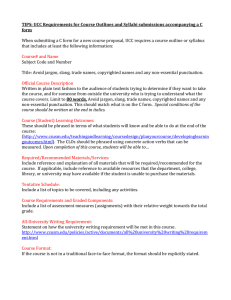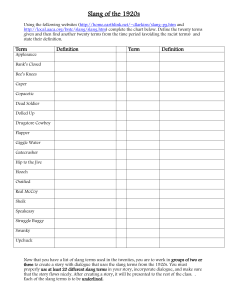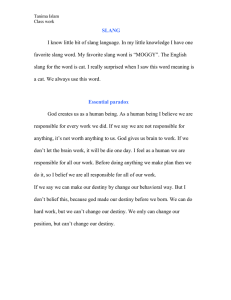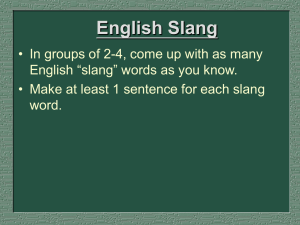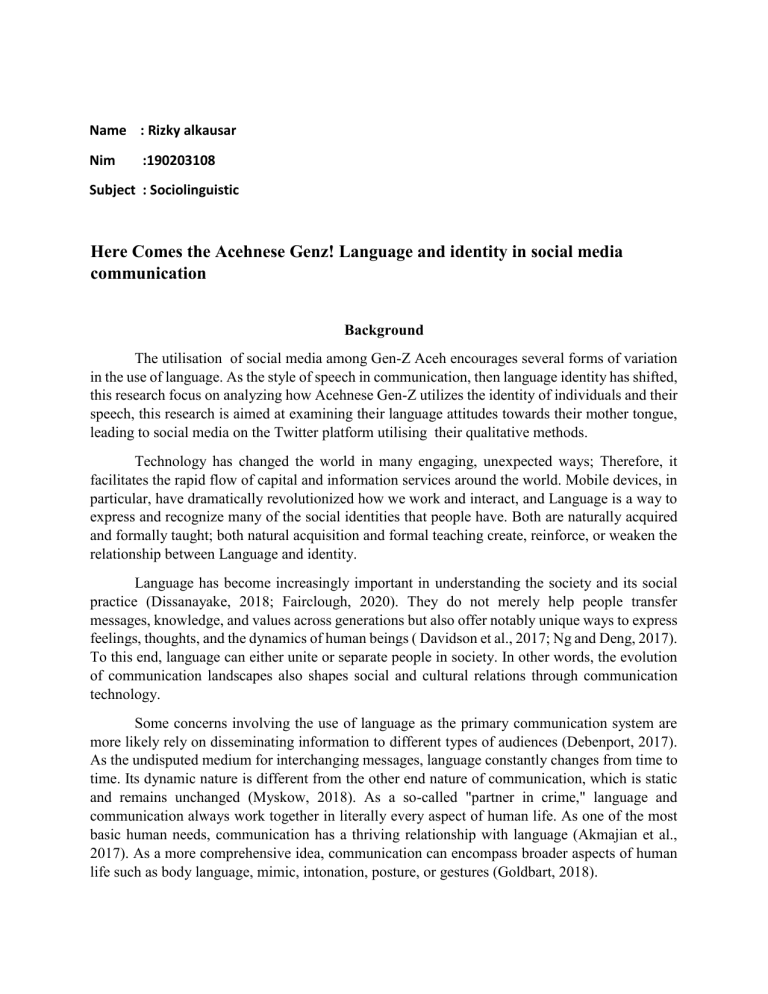
Name : Rizky alkausar Nim :190203108 Subject : Sociolinguistic Here Comes the Acehnese Genz! Language and identity in social media communication Background The utilisation of social media among Gen-Z Aceh encourages several forms of variation in the use of language. As the style of speech in communication, then language identity has shifted, this research focus on analyzing how Acehnese Gen-Z utilizes the identity of individuals and their speech, this research is aimed at examining their language attitudes towards their mother tongue, leading to social media on the Twitter platform utilising their qualitative methods. Technology has changed the world in many engaging, unexpected ways; Therefore, it facilitates the rapid flow of capital and information services around the world. Mobile devices, in particular, have dramatically revolutionized how we work and interact, and Language is a way to express and recognize many of the social identities that people have. Both are naturally acquired and formally taught; both natural acquisition and formal teaching create, reinforce, or weaken the relationship between Language and identity. Language has become increasingly important in understanding the society and its social practice (Dissanayake, 2018; Fairclough, 2020). They do not merely help people transfer messages, knowledge, and values across generations but also offer notably unique ways to express feelings, thoughts, and the dynamics of human beings ( Davidson et al., 2017; Ng and Deng, 2017). To this end, language can either unite or separate people in society. In other words, the evolution of communication landscapes also shapes social and cultural relations through communication technology. Some concerns involving the use of language as the primary communication system are more likely rely on disseminating information to different types of audiences (Debenport, 2017). As the undisputed medium for interchanging messages, language constantly changes from time to time. Its dynamic nature is different from the other end nature of communication, which is static and remains unchanged (Myskow, 2018). As a so-called "partner in crime," language and communication always work together in literally every aspect of human life. As one of the most basic human needs, communication has a thriving relationship with language (Akmajian et al., 2017). As a more comprehensive idea, communication can encompass broader aspects of human life such as body language, mimic, intonation, posture, or gestures (Goldbart, 2018). Above all, identity is the prime issue in language and communication. The principal purpose of utilising language and communication is to represent the language users' and communicators' identities (Evans, 2018). As language represent the culture, identity, status, and another particular gist of an individual or community, one cannot generallyoverlook that identity in language is an unparalleled component of society (Bond, 2019). Successively, we have seen how language changes in communication have also ultimately alteredthe way people express their opinion, agreement, or disagreement in the media they use over time (Davoodi, Waltenburg, and Goldwasser, 2020). As the youth progressed swiftly in social media platforms and communication, their language represented their changed identity and simultaneously discarded the other language in a peculiar way (Manago et al., 2021). Gen-Z, or the youth, exchanges emotions with emoticons, memes, and other means necessary to convey meanings (Penney, 2019). Because for them, utilising several modes of unique language selection and communication practices has positive or negative feedback on a different languagefrom the ones they use in social media (Ezzat, 2020). This language awareness and attitudes are fundamental in ensuring logical meaning is comprehended by different types of audiences. In short, language and communication are central to makingglobal screen culture identity, with social media serving as the main ingredients. Core issues 1. how social media platforms can shape and construct the Acehnese Gen-Z's identity direction 2. how Acehnese Gen-Z language can influences their individual and speech community identities. 3. Scrutinize their language attitudes towards their native language and their own social media language on the Twitter platform Methodology This research Utilising a qualitative method with a critical sociolinguistic and critical discourse analysis approach in order to achieve the purposes, this study applied semi-structured interviews and smallscale social media monitoring on the participants' Twitter accounts to obtain the answers and the reason behind the answers, Interview questions were asked to participants for approximately thirty minutes. Purposive sampling techniques are then utilised in selecting the participants. This approach was preferred since the study focuses on the typical characteristics of a particular group (Etikan, Musa, and Alkassim, 2016). The criteria of participants were identified as member of Gen-Z community group. They were born in 1997 at the latest or aged no older than 24 years old by this writing in 2021. They are active social media users, especially Twitter, live in Aceh, and use idiosyncratic language, i.e.,slang, Jargon in their Twitter communication. Hence, the selected participants are three individualswith the following profiles: Table 1. The Participants' Profile No. Gender Initials and Age Female — 19.y.o 1 2 ZAM 3 CAR Female 22.y.o — Female - 23 Social Media Platform Twitter Twitter Twitter y.o Source: Data Analysis, 2021 All participants in This study are young adult women because they are more likely engaged in social media than their male counterparts, As a result, they have more followers in social media accounts than the opposite gender, For both language attitude and the use of slang and Jargon in their everyday communication, gender differences do not play a significant role in the process of analysis in this study. This is mainly because male social media users, especially in our case, use more local language (Acehnese) compared to their female counterparts. In analyzing the data, this research utilised the following phases of qualitative analysis introduced by (Miles, Huberman, and Saldana, 2019). First, the data has to be organized and reduced from redundant information. Second, we displayed and consolidated data for further analysis and interpretation. The third phase is conclusion and verification. The last, this data needs durability and conformability check. Founding The results of this research composed the identification and analysis of words and phrases consider as a Slang and Jargon that were found in participant Twitter accounts. Additionally, the classification of those words and phrases classified into 11 different social identity categories related to sexual orientation, religion or spiritual affiliation, ethnicity, age, first language, socioeconomic class, physical, emotional, and developmental ability, biological sex, gender, race, and national origin. The classification based on Social Identity Wheel adapted from Hall (2011). Slang and Jargon found on participants' social media are primarily influenced by age, first language, and socio-economic factors. 1. Slang The Analysis of Slang Related to Age The age of a individual is influential on how they utilise slang. The slang from youths has a vital role on identifying social groups. Slang, like fashion, evolves along with the times and it is constantly changing. When a word is considered trendy this year, it might become radically outdated the following year. An individual from previous century would have had difficulty on communicate with individual who utilising the current slang. The internet has changed this natural language evolution, as it continuously absorbed a new slang terms and phrases on social media to some extent it will exceeds the capacity of the human mind to understand. “ The Examples of the words that has the natural word order in order to transform into non-formal and contain some jokes on it are :gud (good), leuv (love), thankyiw (thankyou), welkam (welcome), sowry (sorry), wut (what), galaw (galau = confusion), azeq (asik = too much fun), anjir (anjing = to expressshocked reaction;), chubs (chubby), gaes (guys), and lyfe (life).” A group of people often utilising slang to improve the friendliness and comfort of social interactions and to communicate closeness and equality. “ The participants also utilised others slang such as ngerumpi (gossiping), komunitas tea party (gossiping community), nge-stan (be an overzealous or obsessive fan of a particular idol), you know lah (you already know), sobat — supposed to be sahabat (buddy), sans or santai (to relax in the face of various circumstances immediately), uncul/unyu or imut (cute), uwu (happy expression), mewek or menangis (crying), gaada Obat or qeren (cool), spanning or marah (mad), fix or pasti (definitely), and bacot which stands for "banyak Bocot" (too much talking).” Those slangs are found in participants' edgy conversations on Twitter. Therefore this slang consider as impolite if it is utilised on formal meetings, and on the speech of adults daily conversation. Time-saving online shortening in the form of acronyms and abbreviations, or Slang like BTW (By The Way), Tbh (To Be Honest), Cmon (Come On), Szn (Season), Romcom (Romancecomedy), Wth (What The Hell), and IDK (l Don't Know). Those are examples of English shortening the version of their language which utilised in social media. Meanwhile, some other examples, such as : gaje orga jelas (unclear), B ajaor Biasa aja (Not so so), samsekor sama sekali (At All), and bucing or budak kucing (Cat's Slave) are now part of the Gen-Z language across Indonesia, including in Aceh. The fundamental reason for utilising the Internet-specific slang is to make communication more interactive (Kulkarni and Wang, 2017). While slang shortcuts save the user time, they take the reader outside the social class considerably longer to comprehend. The Analysis of Slang Related to First/Native Language The participant occasionally utilising slang related to their first language, Acehnese, from the data collected. The word"Hayeu kali" is from Acehnese Language means "Asik sekali” In Indonesian language (bahasa), and means "Too much fun" in English. 2. Jargon Jargons exist to express the identity of a specific group or profession. One of the participants utilised several jargon such as "Slow bar" which means a concept that offers a cup of coffee and any information about the coffee ordered when barista and customers have conversation interaction. Another jargon that she utilised on Twitter is "Kalibrasi” or Calibration, which means an activity carried out to determine the quality of coffee, starting from recognizing, differentiating, and comparing coffee. It defines that the participant works as a barista in the coffee shop. She utilised Jargon related to coffee making. Another participant also utilised several jargon, Nge-adju (Adjudicator = Judge), it's a term for a debate competition. An adjudicator is an individual of authority or a legal professional who presides over arbitrates and eventually judges a formal dispute. Adjudicator, as a phrase, essentially means "Judge", without utilising the formal title. Another term is the "Chair"; the chair or chairperson fulfills a various roles in debating competitions. They initiate the argument by reminding the audience of the debating rules and introducing the motion, the proposition, and opposition speakers. After analyzing her tweet with so many debating terms or Jargon, she represents one of the debating members. 3. Code-Mixing and Code-Switching From the data collected, the participants utilised code-mixing and codeswitching on their Twitter accounts. They mixed Indonesia Language, English Language, and the local/native Language (Acehnese language). They are more likely utilisd some English in Indonesian language conversation. For example, "tiap upload story sama cowok pasti dishare heran". They utilised the English word "upload,""story," and "share" as insertion code-mixing in their Twitter accounts. Another example of mixing the Indonesian language and then local Acehnese language can be seen in "keadaan sabee lam panik". In this expression, they utilise one word in Indonesia,"keadaan" which means the condition, and "sabee lam panik" which means "always panic". Those are examples of code-mixing because it contains elements from two different languages in a single utterance. The general structure of one language is determined by the language into which the constituents of the other language are placed. From this utterance, Indonesian words are inserted into a structure defined by the Acehnese language. Table 2. Code-switching and code-mixing utilised by the participants No Utterances Codeswitching Codemixing 1 2 3 4 Setiap upload story sama cowok pasti di share, heran Plotnya rapih!!! gak maksa samsek. waktu nonton ga sadar lah tiba2 udah abis aja saking keasikan. worth to watch! keadaan sabee lam panik Should I take a break from social media? tapi susah apalagi udah kebiasa pake web. jadi entar pasti noh pas buka laptop google ya buka sosmed. Source: Twitter, 2021 The participants also use code-switching during the conversation on Twitter, for example: gak maksa samsek. waktu nonton ga sadar lah tiba2 udah abis aja saking keasikan. Which means worth to watch!" Additionally, the phrase is classified as code-switching since the two varieties of language are switched between sentences, and the two varieties of language remain distinct in the bilingual utterance. First, the participants explain the movie in Indonesian and switch the language to amplify their opinion. Another statement is "should I take a break from social media? tapi susah apalagi udah kebiasa ..."they speak in two languages at the same time in one conversation. They change their language from English to Indonesian without indicating any change in the language they are speaking. This involves a single shift on a particular topic. Code-switching and code-mixing are utilised to convey a group's identity. Educated persons in their discipline groupings communicate distinctly from that of the other groups in society. Mostly the participants use codemixing and code-switching with Indonesian and English language. When it comes to social status, the use of the English language is seen as a sign of privilege. Consequently, elite families enroll their children in English medium schools to reach a higher social, cultural, and political position. Conclusion This research composed that the Indonesian Gen-Z language use has provided a complete understanding of the identity formation process whereby specific language patterns in a community are frequently utilised during social media communication. Current findings also reflect the fragmented reality that the screen culture effect in digital communication towards Acehnese Gen-Z's communication style plays a critical role in the youth social identity formation in Aceh. However, the relationship between the two closely related processes is still unclear and thus requires further inquiries with more participants and digital data in social media. For example, the participants admitted that utilising slang language or Jargon and doing code-switching and code-mixing interchangeably in their social media communication serves as the symbol of their language creativity and part of their newly formed unique social identity and status. Although their language attitudes towards Acehnese their native language- are unanimously positive, their language attitudes towards their own social media language use are not entirely positive. On the other hand, they also realized that those kinds of language uses are, to some extent, harmful, damaging, or dangerous for their native language preservation. Consequently, it is difficult to make a straightforward judgment between these two opposing realities. Advantages This research Provide an explanation of positive and negative attitude towards The influences of social media on shaping the language used among the youths This research Consist Several examples of the language changes, such as slang, jargon or code switching and code mixing This research composed the identity constructing process caused by social media Disadvantages This research doesn’t provide an explanation about Gen-z terminology The sample of this research is only female, however the language changes also occur among the male The way that researchers concluded the conclusion is seems too general Suggestion Researchers need to provide explanations regarding terminology such as Gen z This research need to choose the sample from both gender because language changes due to social media also often occur among male Drawing conclusions behind the reasons for using slang, jargon, code switching and code mixing must be included more specifically for each individual because there is possibility that the reasons behind the language change differ from one individual to another. References Rios-González, O., Peña Axt, J. C., Duque Sánchez, E., & De Botton Fernández, L. (2018). The language of ethics and double standards in the affective and sexual socialization of youth. Communicative acts in the family environment as protective or risk factors of intimate partner violence. Frontiers in Sociology, 3. https://doi.org/10.3389/fsoc.2018.00019 Howard, R. G. (2022). Manufacturing populism: Digitally Amplified Vernacular Authority. Media and Communication, 10(4), 236–247. https://doi.org/10.17645/mac.v10i4.5857 Suchacka, M., & Zawojski, P. (2022). The role of New Media in shaping a creative environment for regional development. Creativity Studies, 15(2), 511–525. https://doi.org/10.3846/cs.2022.14783 Boonpracha, J. (2022). Arts and culture as creative learning of students through cultural product design. Creativity Studies, 15(2), 364–375. https://doi.org/10.3846/cs.2022.14307 Suchacka, M., & Zawojski, P. (2022). The Role of New Media in Shaping a Creative Environment for Regional Development. Creativity Studies, 15(2), 511–525.https://doi.org/10.3846/cs.2022.14783
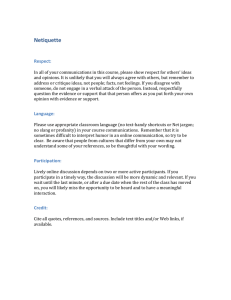
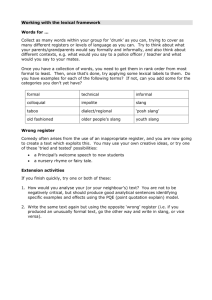
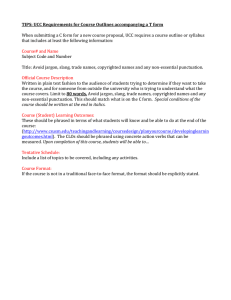

![Structure and Style of WritingCh.2ppt[sept17]](http://s2.studylib.net/store/data/009833812_1-9c1e0f686de252923f01c9dfd6dc943b-300x300.png)
